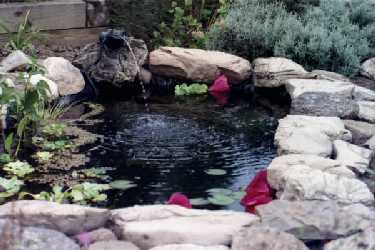

Is there anything more relaxing, more serene, than the sight and sound of a water feature in the garden? It must be the ultimate luxury, even in areas where water is in abundant supply. The desire for one had been in the back of my mind for many years, but every time it came to the fore, I pushed it back, daunted by the seeming complexity and expense of such a project.
In July 2000, my hand was gently forced by a gardening friend. She phoned me one afternoon, bubbling like a brook. "You have GOT to go to Wal-Mart to buy a pond kit!" she insisted. I drove to her house to take a look at the one she had just installed. It was delightful, and her description of the installation made it sound like child's play. I decided to take the plunge.
I knew the perfect spot for my little water garden: the lower terrace, right at the edge of the circular fieldstone patio, where it would be passed on the way to our front door. It would also be visible from a window in the kitchen, where my husband and I spend a great deal of time. The site decided, I impatiently began lifting plants from the area. When that was done, I ran out to purchase a $75 Beckett Pond Kit, consisting of a heavy black vinyl liner, a recirculating pump, flexible vinyl tubing with a cute little frog "spitter", and a bottle of water treatment to counter the chlorine and chloramine in our tap water.
I spent the next three days digging through hard-baked clay and basketball-sized rocks to create the 5' x 9' x 18" hole in the ground. I fastidiously cut the shelf for potted water plants, being ever so careful not to disturb the soil behind and below it. It was a beautiful sight, and site, when I finished, with graceful, sculpted contours.
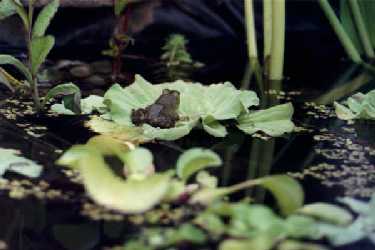 |
There is an old carpenter's adage: "Measure twice, cut once." The ponder's equivalent is "Measure twice, dig once." Yep, I managed to dig the hole larger than the liner! The lovely contours I had chiseled so carefully were lost when I had to backfill; the unstable soil shifted as I put down the underlayment and liner. Then, when I attempted to smooth out the wrinkles as the pond filled, clods of dirt fell from the edge of the liner into the water. Can you say "mud"? |
Oh, but the trouble didn't end there. Once filled, the importance of leveling the soil precisely hit home. I had merely "eyeballed" it, and my eyeballs, apparently, aren't very good! One side of the pond is a full three inches higher than the other. I corrected as best I could, but because of the "shortage" of liner material, it was impossible to do a perfect job.
Oh well, that's where plants come in, and plants were on the way! Within a couple of days, UPS delivered a fine selection of lizard's tails, pickerel reed, water hyacinth, water lettuce, and duck weed. My friend Arleen contributed parrots' feather, water forget-me-not , and a dwarf waterlily. (I am still trying to learn the scientific names of these things.) The discrepancy in height is still apparent, but the plants definitely help disguise my failings.
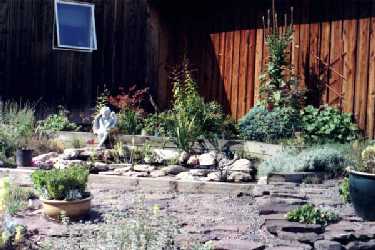 |
The glacial drumlins of Western New York have an abundance of rocks, but all the flat ones seem to have been deposited on somebody else's land. The ones I used to edge the pond are much too high and rounded, but they will suffice until I amass a supply of rocks of the proper dimensions. This photo illustrates the importance of leveling; notice the liner on the back side? |
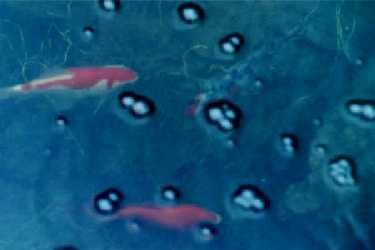 |
A water garden ought to have fish! Goldfish are hardy and undemanding, and the common ones are also inexpensive. I suppose that is why I regarded them as "expendible". A funny thing happened, though, when I became responsible for three little fishies: I realized they have distinct personalities. Now they are pets, and pets have to have names. Meet Jelicu (top) and Goldie. (Merlin was in hiding at the time.) |
The first month went, well, swimmingly. I loved the play of light on the water, the cooling sound of water splashing from the spitter into the pond, the fish begging for a handout at my footfall. Then one day, a green monster appeared: planktonic algae. The water became so murky I couldn't see more than a couple of inches below the surface. Fortunately, I had by that time discovered the Pond and Aquatic Plants Forum at GardenWeb. There, veteran and novice watergardeners alike were quick to offer advice and solutions, and from them I learned that this is perfectly normal in the life of a new pond. Also with their help, I constructed an inexpensive in-pond bio/mechanical filter using a Rubbermaid tote, which helped immensely. If you are thinking about creating a watergarden, visit an online forum before you start digging your pond! My current favorite for fun and information is JB's Forum.
The most remarkable discovery was that a little watergarden supports an amazing variety of life forms. Within a very short time the pond was teeming with creatures who somehow found their way there: tiny snails, at least three distinct kinds of frogs, strange worms, and myriad insects - all miraculously appeared and found my pond to their liking. Dragonflies skim the water's surface, their metallic bodies and gossamer wings glinting in the sun. Birds and bees, and yes, even an occasional dog, stop by for a drink. Undoubtedly there are nocturnal visitors, as well. I have had no casualties from locally abundant herons and raccoons, but I won't be surprised if it happens eventually.
A most wonderous aspect of the pond revealed itself late one August night on the way back from taking my dog out. Drawn by the sound of the water, I sat in the dark by the water's edge. As if for my benefit alone, a huge golden moon appeared above the treeline, illuminating the ripples and turning the stream from the spitter to a ribbon of liquid silver. With a night chorus of crickets and frogs as counterpoint to the melody of the water, and the scene bathed in shimmering moonlight, I felt as though I had tumbled into a page of A Midsummer Night's Dream. (I wonder if the old bard drew his inspiration from a watergarden?)
As we headed into late fall, I cut back all the marginal plants, trimmed and sunk the water lily to the bottom of the pond, trimmed the anacharis and hornswort (oxygenating plants that grow below the surface), and tried to keep the water free of falling leaves. I decided to leave the pump and filter running through the winter to keep at least a little of the surface ice-free, so there will be no build-up of toxic gasses to harm the fish. The process of winterizing the pond led to another surprise: the fish had spawned when I wasn't looking, and I am now a "grandfisher"! This posed a dilemma: should I take a chance that the fry would live through the winter with little fat reserve, or educate myself about aquarium life and bring them inside? I brought them in. I now have eleven little goldfish in a ten-gallon tank in the living room. What better way to while away the winter as I plan the new, improved pond I'll be digging in the spring?!
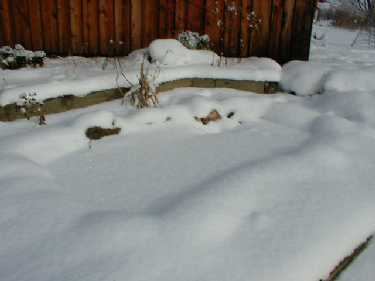 |
Winter 2000-2001: I wasn't quite sure what the pond would look like under a blanket of snow. I hoped it would have a special seasonal beauty all its own, and I guess it does - but I still prefer the way it appears in the warm seasons! |
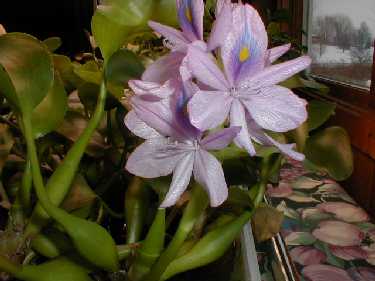 |
Since the pond is not much to look at, I am enjoying experimenting with overwintering some water hyacinths. I brought in a half-dozen plants before frost and have them growing them under fluorescent lights in tubs of water. A little Miracle-Gro and abundant light have encouraged them to reproduce and bloom. With money saved, perhaps I'll be able to buy some water lilies in the spring. |
 |
Larry the cat has discovered the baby goldfish in the 10-gallon tank. He spends hours watching them. Fortunately, he's not the sharpest knife in the drawer - he has not yet figured out that he could do some real fishing through the hole in the plexiglass cover! |
Spring 2001: The advance of the first spring was as much a mystery as the first winter had been. Despite all assurances, I was anxious to learn whether fish and plants had survived the harsh conditions.
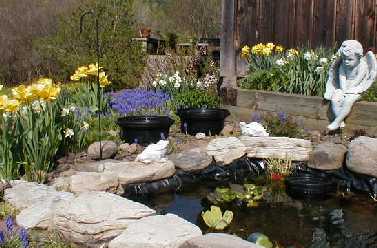 |
The pond awakened slowly, and the answer was revealed in quiet hints. When at last the daffodils bloomed, the waterlily stretched and smiled at the sun. In untempered haste, I foolishly introduced some over-wintered floating plants. I painfully report that they were killed by frost soon after I tossed them in. Sigh. Live and learn. |
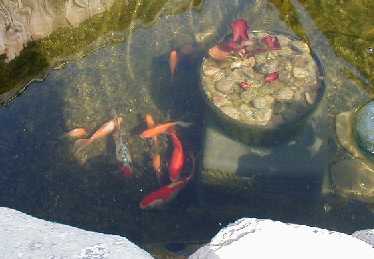 |
The biggest surprise in the awakening was the startling appearance of numerous fry, the siblings of those with whom I had taken such pains through the winter! (There will be no preferential treatment next year!) The fish gradually became more active until at last they raced through the sparkling clear water in the age-old spawning ritual. I need some bullfrogs to keep the fish population in check. |
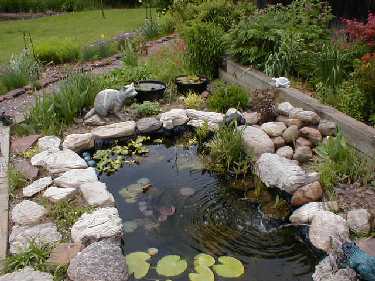 |
I did some rearranging of statuary when it suddenly occurred to me that the raccoon in another garden belonged beside the pond. The cherub was moved and now awaits a permanent position in the large perennial garden on the north side of the house. |
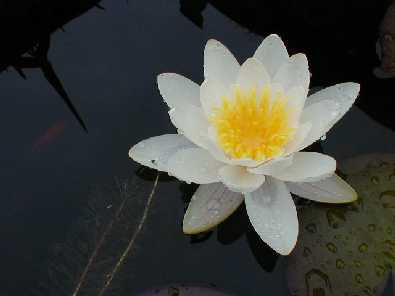 |
This lovely blossom is that of an un-named waterlily, the very first inhabitant of the virgin pond. It was worth the wait! I think this means I will be enlarging the pond to accommodate several more. I had plans to do that this spring, but I decided to wait to make certain of my plans. Another year of experience can't hurt, either! |
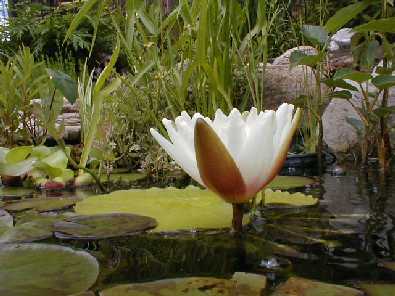 |
This is the second blossom from the same plant. The first blossom sat on the surface of the water. This one is elevated above the surface. The scene looks so exotic to me! The pale green pads belong to a Giant White Snowflake. A blossom from Nymphaea 'Colorado' will follow soon. |
Winter 2001-2002 My first full year of ponding was not without frustrations, but I have come to accept that no pond - not in nature, and not manmade - is perfectly balanced and crystal clear year round. I had a major problem with algae this past summer. Every morning the pond was clear and lovely. Every afternoon the water was topped with a sickly green growth that had a sort of bubbly quality. I tried cleaning the filter more regularly, which helped somewhat, and I cleaned the bottom more frequently with my Pond Vac. (Incidentally, this is a GREAT product for the small pond!) What helped most was increasing the aeration. This coming spring I plan to add a "veggie" filter in the terrace above the pond. This should use up any excess phosphorus in the water, INhibiting algae growth. The water, after being filtered through the plant roots, will fall into the pond, adding oxygen in the process.
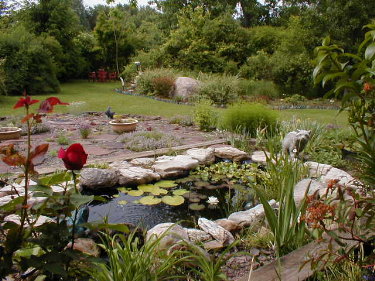 |
Here is my little pond in July, taken from the terrace above. The veggie filter will be constructed where I am standing to take this picture. The water will flow over the lip of the landscape timber, which will be covered with pond liner, and from there over the rocks and into the pond. Or at least that is how I envision it now! |
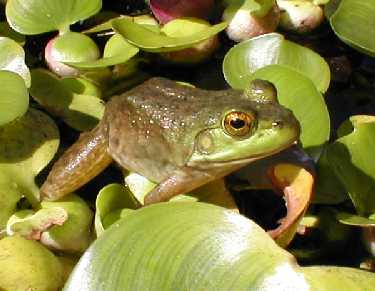 |
Every day brings a new discovery at the pond. I'm not sure this little fellow was as glad to meet me as I was to meet him, but he allowed me to get close enough to take this fine portrait. The older bullfrogs were much more wary and dove into the water at my approach, no matter how slowy I moved. |
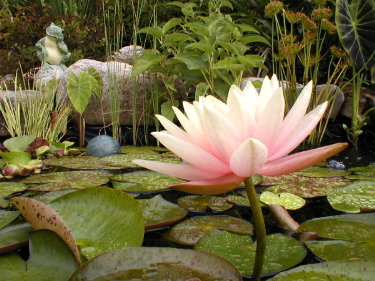 |
'Colorado' was an inexpensive eBay purchase that rewarded me with lovely blossoms all summer long. It seems that most (perhaps all) waterlily blooms last but three days. The blossom presents itself differently, but beautifully, each day. At the end of the third day the blossom just droops beneath the surface of the water. If the blossom was fertilized, it eventually becomes a jelly-like mass in which seeds form. I cut spent stems to prevent their rotting in the water. | 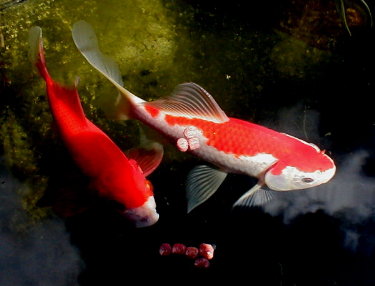 |
This is Jelicu and Goldie again, looking quite a bit bigger than the last time you saw them. I feed my fish only rarely, and even then, not because they need processed food, but just so I can enjoy them at close range. (Please notice how my fish pictures have improved! Practice, practice, practice - and a better camera!) |
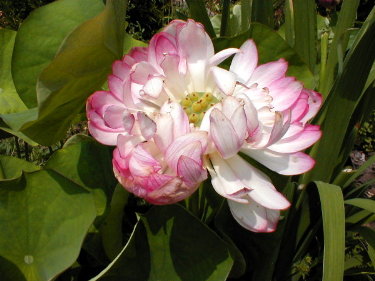 |
Tempted by raves of my online pond friends, I just had to try growing a lotus this summer. I couldn't grow it in the pond because my shelf is not configured in a way that will accomodate such a large pot, so I grew it in a large tub out of the pond, making sure to keep it topped with water. This is a bloom of 'Ben Gibson' on the third day. The pot is being wintered on the bottom of the pond. Is it still alive? Only time will tell...please come back to find out! |

| Go Home | Stroll in The Garden |
| Read about The Basenji | Visit the Puppy Parade |
| View My Art |